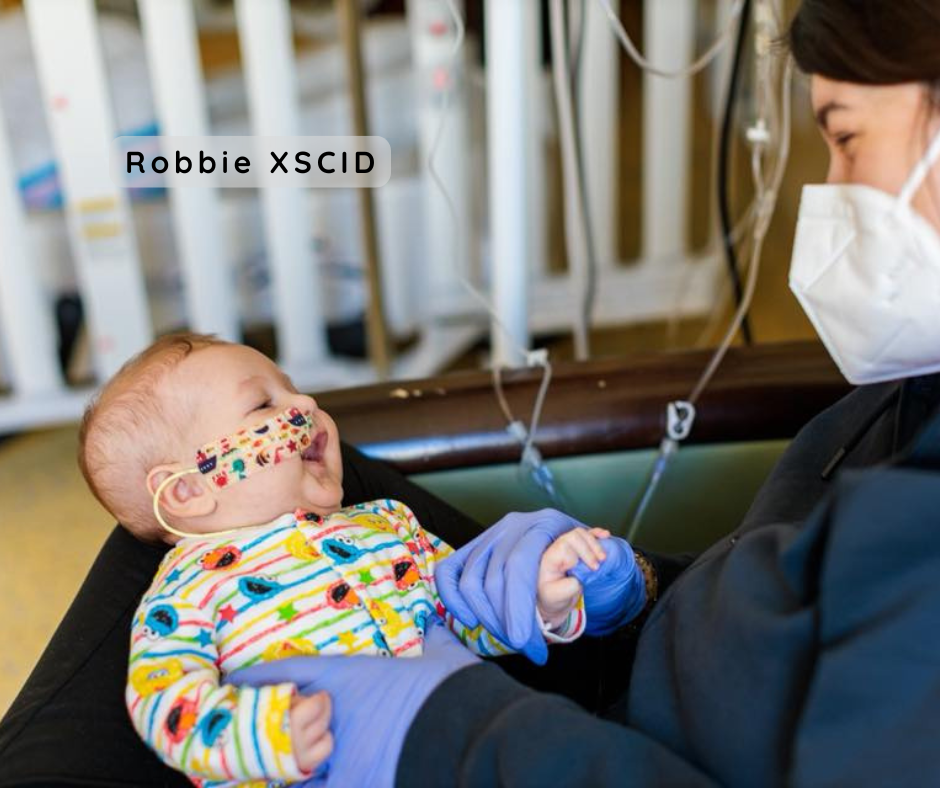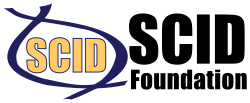
Even if there’s no family history, parents can still be carriers without knowing it. That’s why newborn screening is so important. It helps catch SCID early, even in families who had no idea they were at risk.
Types of SCID
Did you know there are over 20 different types of Severe Combined Immune Deficiency (SCID)? Each type is linked to a specific genetic mutation, which means the exact gene involved plays a big role in how the disease affects the immune system.
Understanding your child’s specific type of SCID is crucial because treatment options vary based on the genetic cause. A precise diagnosis helps doctors choose the most effective path forward—whether that’s a bone marrow transplant, gene therapy, or another targeted approach.
T cells play a central role in protecting our bodies from infections, and several different genes are involved in their development. When even one of these genes doesn’t function correctly, it can lead to Severe Combined Immune Deficiency (SCID).
We often name the type of SCID based on the specific gene that’s affected. For example, ADA-SCID is caused by changes in the ADA gene. ADA stands for adenosine deaminase. The ADA gene provides instructions for making the adenosine deaminase enzyme, which helps break down toxic substances in immune cells. When it’s not working, the immune cells can’t survive.
Doctors may also describe SCID by looking at which types of white blood cells are present or missing—specifically T cells, B cells, and NK (natural killer) cells. For example, someone with T-B-NK+ SCID has low or no T and B cells, but normal levels of NK cells.
No matter the subtype, the key issue in all forms of SCID is the lack of functional T cells, which are crucial for fighting viruses, bacteria, and fungi. That’s why SCID is considered a medical emergency in infants and why early diagnosis and treatment are life-saving.
What if no one in the family has had SCID before?
Even if there’s no family history, parents can still be carriers without knowing it. That’s why newborn screening is so important—it helps catch SCID early, even in families who had no idea they were at risk.
X-linked SCID
The most common form of SCID is IL2RG SCID often called XSCID, or X-linked SCID, which only affects boys.
Caused by a mutation in the IL2RG gene on the X chromosome, affecting T and NK cell development. B cells are present but don’t function properly. T-B+NK-
X-linked diseases occur because of a mutation in a gene on the X chromosome.
-
Girls have two X chromosomes (XX).
-
Boys have one X and one Y (XY).
If a mom carries the gene mutation on one of her X chromosomes:
-
Each son has a 50% chance of having the disease, since boys only get one X chromosome.
-
Each daughter has a 50% chance of being a carrier, like her mom.
Other Forms of SCID
How Is Non–X-Linked SCID Inherited?
Not all types of SCID are linked to the X chromosome. In fact, most types of SCID are inherited in what’s called an autosomal recessive pattern.
What does autosomal mean?
“Autosomal” means the gene involved is on one of the non-sex chromosomes (we have 22 pairs of these, plus one pair of sex chromosomes). So the gene causing the SCID isn’t on the X or Y chromosome—it’s on one of the other 22 pairs.
What does recessive mean?
“Recessive” means that a person needs to inherit two copies of the non-working gene (one from each parent) in order to have SCID.
Here’s how it works:
-
Each parent carries one copy of the non-working gene, but they also have one healthy copy.
-
Because they still have one healthy, working copy, they don’t have SCID themselves—they’re just carriers.
-
When two carriers have a child, there’s a:
-
25% chance the child inherits both faulty copies and has SCID
-
50% chance the child inherits one faulty copy and becomes a carrier (like the parents)
-
25% chance the child inherits two healthy copies and is neither affected nor a carrier
-
Both boys and girls can inherit autosomal recessive forms of SCID
Some of the Types of Autosomal Recessive SCID
ADA-SCID (Adenosine Deaminase Deficiency) T-B-NK-
This type is caused by a problem in the ADA gene. Without ADA, toxic substances build up in immune cells, causing them to die. It’s one of the most common types of SCID.
RAG1 and RAG2 Deficiency SCID T-B-NK+
These genes help immune cells “shuffle” their DNA so they can recognize germs. Without them, T and B cells can’t develop properly.
RAG Deficiency with Omenn Syndrome T-B-NK+
In some cases, RAG1 or RAG2 genes partly work, but cause severe inflammation and rash—this is called Omenn syndrome. It’s like having immune cells that are present, but confused and overactive.
IL7R SCID (Interleukin-7 Receptor Deficiency) T-B+NK+
IL7R helps guide the growth of T cells. When this gene doesn’t work, T cells can’t mature, but B and NK cells may still be present.
DCLRE1C (Artemis) SCID T-B-NK+
Artemis helps repair broken DNA in developing immune cells. Without it, the body can’t make healthy T and B cells. Artemis SCID is especially sensitive to radiation as well as some medications that damage DNA, such as chemotherapy.
JAK3 Deficiency SCID T-B+NK-
JAK3 helps send signals inside immune cells. Without it, the body can’t make T or NK cells, though B cells might still be there but won’t work well.
CD3 Complex Component Deficiency SCID T-B+NK+
The CD3 complex is like an “on switch” for T cells. If any part of it is missing, T cells can’t develop or function properly.
Coronin-1A Deficiency SCID T-B+NK+
This rare form affects how T cells move and survive. It can also affect other white blood cells involved in fighting infection.
CD45 Deficiency SCID T-B+NK+
CD45 helps immune cells communicate. Without it, the immune system can’t launch a proper response to infections.
DNA Ligase IV Deficiency SCID T-B-NK+
This gene is needed to fix DNA breaks when immune cells are forming. Its loss can cause SCID along with growth problems and sensitivity to radiation.
DNA-PKcs Deficiency SCID T-B-NK+
DNA-PKcs is another gene involved in DNA repair during immune cell development. Without it, the body can’t make working T and B cells.
LAT Deficiency SCID (Linker for Activation of T cells) T-B+NK+
LAT helps send activation signals inside T cells. Without this signaling, T cells can’t become fully functional.
Reticular Dysgenesis SCID T-B-NK-
This is one of the most severe types of SCID. It affects not only T and B cells, but also neutrophils (important infection-fighting cells), leading to life-threatening infections from birth.
Cernunnos-XLF Deficiency SCID T-B-NK+
Another DNA repair-related form. Like Artemis and DNA Ligase IV deficiencies, it affects how immune cells rearrange and repair their DNA.
CD3 Chain Deficiencies (CD3D, CD3E, CD3Z mutations) T-B+NK+
CD3 complex is essential for T cell receptor signaling. B and NK cells are present but B cells may not function properly.
ZAP70 Deficiency T-B+NK+
ZAP70 is crucial for T cell receptor signaling. Its deficiency leads to absence of functional T cells; B and NK cells are present.
Bare Lymphocyte Syndrome Type II (MHC Class II Deficiency) T-B+NK+
MHC Class II molecules are essential for T cell activation. Their absence leads to non-functional T cells; B and NK cells are present.
CHH-SCID (Cartilage-Hair Hypoplasia–associated SCID) T-B+NK+
People with CHH have a mutation in the RMRP gene, which affects how cells grow and divide. It can cause very short stature, fine sparse hair, and in some people, a severe problem with the immune system like SCID. In those with SCID, the body can’t make enough working T cells, while B and NK cells are usually there but may not work well.
*Congenital Athymia (non-SCID)
While some forms of Congenital Athymia result in T-cell absence, making it similar to SCID, it is not caused by a problem in the T cell genes, but in thymus formation. Therefore, it is not classified as SCID even though it can look very similar and is often identified after an abnormal TREC test.
Treatment Options
Hematopoietic Stem Cell Transplant (HSCT)
Hematopoietic Stem Cell Transplant is the standard treatment for all types of SCID. In HSCT, donor stem cells are introduced into the child and develop an immune system.
You may also hear the terms Stem Cell Transplant (SCT) or Bone Marrow Transplant (BMT). BMT refers to bone marrow specifically, whereas HSCT is a broader term that can involve bone marrow, peripheral blood, or umbilical cord blood as sources of stem cells. SCT is the most general term, including any kind of stem cell transplant, even ones that don’t involve hematopoietic cells.
Enzyme Replacement Therapy (ERT)
Enzyme replacement therapy for ADA-SCID provides the body with a lab-made version of the adenosine deaminase (ADA) enzyme. People with ADA-SCID are born without enough of this enzyme, which is needed to break down certain toxic substances in the body. Without it, these substances build up and damage the immune cells, especially T, B, and NK cells.
By giving regular injections of this enzyme, the treatment helps reduce the toxic buildup, supports the immune system, and allows immune cells to grow and work better. It doesn’t correct the genetic cause, but it can be a lifesaving option while waiting for a more permanent treatment, like HSCT or gene therapy (GT).
Gene Therapy (GT)
Gene Therapy for SCID is a cutting-edge treatment that aims to correct the underlying genetic problem causing the immune deficiency. Gene therapy works by taking some of the patient’s own hematopoietic stem cells (HSC) and inserting a healthy copy of the faulty gene into those cells using a viral vector—a modified virus that acts as a delivery tool.
Once the gene is added, the corrected stem cells are infused back into the patient, where they begin producing immune cells that now have the corrected gene, allowing the immune system to start functioning properly.
Right now, gene therapy is only available through clinical trials. These trials have strict eligibility requirements, which usually include having a specific form of SCID (like ADA-SCID, Artemis SCID, or X-linked SCID), being within a certain age range, and not having other health conditions that could interfere with the treatment.
Gene therapy offers a promising option, but long-term outcomes are still being studied.
